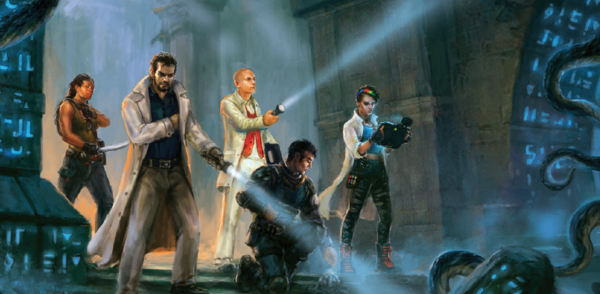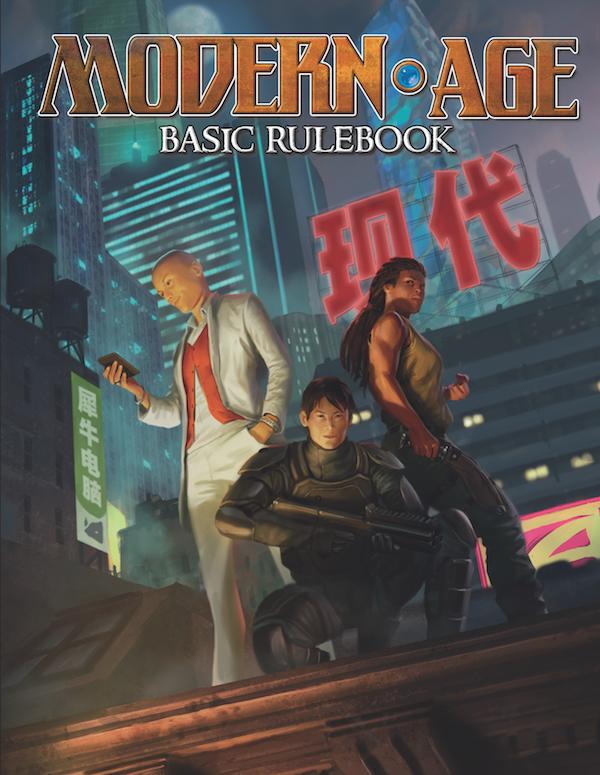
Green Ronin’s Modern AGE Basic Rulebook saw it’s pre-order and release earlier this summer. I’ve been meaning to do a review of the book since I bought my copy, but for some reason or another kept pushing it off. The game uses the AGE engine that was developed for the company’s Dragon Age Roleplaying game and then again for the Fantasy AGE Basic Rulebook. The system is very simple at it’s heart. You roll 3d6 and add any applicable modifiers in an attempt to hit a target number. One of your dice is known as your “stunt die.*” If you roll doubles on your test, you generate a number of “stunt points” equal to the number on this die that you can spend in various ways to modify the result of the test to your advantage.

However, despite the core system being the same, Modern AGE feels like a very different game from the earlier Fantasy AGE release for one reason in particular. This version of the game has done away with the traditional 3 class structure of the previous releases. Dragon Age and Fantasy AGE both had you choose from either the Warrior, Rogue, or Mage archetypes that you then further modified through selections of various talents, ability focuses, or specializations. Some choices were prescribed to you, and others were chosen from a small but thematic list. It never felt overly restrictive, but there was that mechanical constraint to what your character could and could not be. The Fantasy AGE Companion introduced several new options that helped to fill in quite a few gaps that were apparent in character capabilities with just the Basic Rulebook.
“Classes” do not exist like this in Modern AGE. Instead, your character’s starting capabilities are determined by your choices (or the result of the dice if you choose to go in a random direction) in character creation. First up, you determine your background from one of 12 broad ideas such as Military, Trade, or Aristocrat. Backgrounds give you a bonus to one of your nine ability scores, a choice of one of two ability focuses and talents, and a random benefit from the backgrounds table – typically another ability score increase or ability focus.
From there you choose from one of 24 professions like Clergy, Criminal, Politician, or Soldier that further defines your characters starting capabilities. Like your background, your profession gives you a choice between one of two ability focuses and talents. Furthermore, it determines your starting Health score and your starting Resources score (the games measure of wealth).
Finally, you choose a “Drive” for your character. This is why your character gets involved in the action that is happening in the game. Why does your character run towards danger instead of away from it? The drives come with both a quality and a downfall that you and the GM can use to hook your character into the action and help you to roleplay your character at the table. Mechanically speaking, your drive gives you a final choice between one of two talents. It also gives you a choice between one of three “improvements.” Health increases your starting Health total. Likewise Resources increases that score. Membership, Relationship, or Reputation gives you a free first rank in that associated game mechanic. These are things about the character that can be leveraged in play. Reputations can give your character an edge (or setback if the reputation isn’t helpful) in certain situations. Membership has its perks including possible access to information or equipment beyond the character’s reach. Relationships (which are something that every character receives at creation and maintain through play) are bonds with NPCs or other PCs that you can leverage for bonus stunt points to spend on actions relating to that relationship.
As you gain in level, you increase your ability scores, gain more ability focuses, and gain new and more powerful talents. The talent list is expanded from the Fantasy AGE Basic Rulebook, reflecting the fact that you get new ones with more frequency. At certain levels, you can choose from more powerful “specialization talents” such as Sniper, Martial Artist, or Academic that further define what your character is really good at.

The book also provides changes to the basic rules for running the game in one of three modes. “Gritty” is the most “realistic” of the modes in the fact that the characters are undeniably human. They typically don’t perform over the top stunts and maneuvers and even an experienced hero can be brought low by a well placed bullet. “Pulpy” is the second mode which paints the characters into a decidedly more heroic light – think Indiana Jones. These characters are capable of standing up to more punishment and are capable of performing the odd “heroic” task. The final mode is “Cinematic” gameplay. The heroes continue to get tougher and tougher as they advance in level and are capable of withstanding a surprising amount of punishment. Each adversary is written in a way that they can be easily used in any of the modes of play, and any rule that would be modified based on mode is called out with clarity.
The stunt lists have been greatly expanded on from what you’re used to seeing if you’re familiar with Fantasy AGE or Dragon Age, greatly opening up your options when you roll doubles. While this is a welcome sight for someone who has been following the game from the first Dragon Age boxed set, I can see where the sheer number of options might be a little bit overwhelming for someone brand new to the game, but it’s nothing insurmountable. After a few sessions, I have faith that even a brand new player will be comfortable with selecting from the lists of stunts available to them in any given situation.
And of course, the book introduces several sources for supernatural powers – both magic and psychic powers. There are a good number of selections, all presented as talents. However, each talent only offers a total of 4 spells or powers that are all gained upon reaching the highest rank in the talent. Now, there was a similar problem in the Fantasy AGE Basic Rulebook, but they managed to greatly increase the number of available spells and magical traditions in their Companion book, so I’m interested to see how future releases expand on the available options.
The book also spends a good deal of time exploring ways that you could run a Modern AGE game in different themes or time periods and what modes of play would best suit those kinds of games. You could run a gritty cosmic horror game set in the early 20th century inspired by the tales of H.P. Lovecraft or you could run a Cinematic World War II game where the characters are Allied spies racing to stop the Nazis from discovering the mystical city of Shambhala in Tibet. Maybe you want to run a highly cinematic game set in the age of sail where your characters are dashing swashbucklers and daring privateers raiding enemy convoys for King (or Queen) and country. Or maybe you wish to run a game set in the mid-19th century exploring a pulpy version of the Old West as you might see on the western TV serials or movies.
Production wise, the book is gorgeous. It’s hardcover and clocks in at 192 pages full of information. The artwork is in full color and very eye-catching and quite representative and inclusive.
All in all, this is a phenomenal release, and immediately got my gears turning on some ways that the system could be used at my own table. The book retails for $34.95 and can be purchased directly from Green Ronin’s webstore as well as other web retailers and most likely through your local game store. The PDF retails for $18.95 from the Green Ronin webstore.
*Called the Dragon Die in Dragon Age, and the Drama Die in the upcoming Expanse Roleplaying Game
